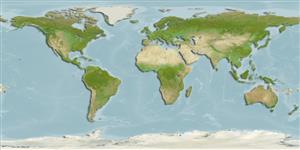>
Ophidiiformes (Cusk eels) >
Dinematichthyidae (Viviparous brotula)
Etymology: Diancistrus: Greek, di = two + Greek, agkistron = hook (Ref. 45335); alatus: Name from Latin 'alatus'; meaning winged, referring to the unusually large, protruding wing-shaped outer pseudoclaspers..
More on authors: Schwarzhans, Møller & Nielsen.
Environment: milieu / climate zone / depth range / distribution range
بوم شناسي
دريايي وابسته به آب سنگ; تغييرات عمق 2 - 7 m (Ref. 57884). Tropical
Central Pacific: Tonga Islands.
Size / Weight / سن
Maturity: Lm ? range ? - ? cm
Max length : 3.2 cm SL جنس نر / بدون خواص جنسي; (Ref. 57884)
توصيف مختصر
كليدهاي شناسايي | ريخت شناسي | ريخت ستجي بوسيله انداره گيري
Body slender, small; vertebrae 11+ 31 = 42; dorsal fin rays 79; anal fin rays 59; outer pseudoclasper large, wing-shaped, bent outwards, with flat, broad supporter; inner pseudoclasper is free, broad-based, bifurcate, its anterior branch twice as long as posterior branch extending over anterior part of outer pseudoclasper, both with rounded tip; scale patch only on cheek, no scales on operculum; otolith length to sulcus length 2.2 (Ref. 57884).
Life cycle and mating behavior
Maturities | تولید مثل | Spawnings | Egg(s) | Fecundities | توزاد ( لارو)
Schwarzhans, W., P.R. Møller and J.G. Nielsen, 2005. Review of the Dinematichthyini (Teleostei, Bythitidae) of the Indo-West-Pacific. Part I. Diancistrus and two new genera with 26 new species. The Beagle, Records of the Museum and Art Galleries of the Northern Territory 21:73-163. (Ref. 57884)
وضعيت در فهرست قرمز IUCN (Ref. 130435)
خطر برای انسان ها
Harmless
استفاده انسانی
ابزارها
گزارش های ويژه
بارگيری XML
منابع اينترنتي
Estimates based on models
Preferred temperature (Ref.
123201): 24.9 - 29.1, mean 26.7 °C (based on 229 cells).
Phylogenetic diversity index (Ref.
82804): PD
50 = 0.5000 [Uniqueness, from 0.5 = low to 2.0 = high].
Bayesian length-weight: a=0.00389 (0.00180 - 0.00842), b=3.12 (2.94 - 3.30), in cm total length, based on all LWR estimates for this body shape (Ref.
93245).
Trophic level (Ref.
69278): 3.1 ±0.5 se; based on size and trophs of closest relatives
Fishing Vulnerability (Ref.
59153): Low vulnerability (10 of 100).
